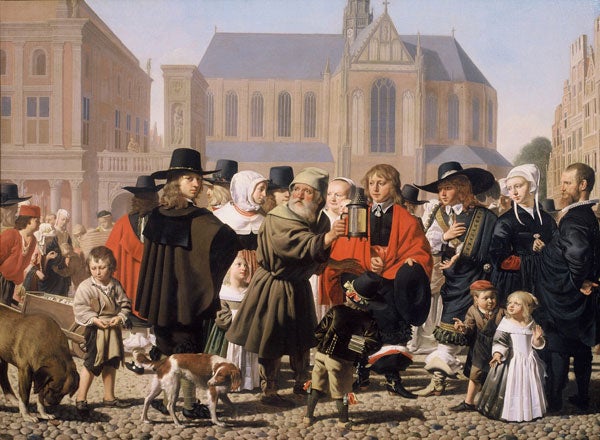Great Works: Diogenes Seeks a True Man (1652), Caesar van Everdingen
Mauritshuis, The Hague

Max Ernst called Magritte's pictures "collages painted entirely by hand". Magritte disliked it, but the phrase sticks. His paintings often perform those weird re-orderings of the world that collage, with its cutting and mixing, is good at. There's a mother with a child in her arms, say. But the woman has a large baby's head and the baby a small woman's. It's as if the heads had been clipped from other pictures and pasted in – a Madonna and Child grotesquely transposed.
Incongruity is the normal sign of collage. Somehow or other things in the picture don't fit together. These jumps arise from the way collage puts together picture-bits that are drawn from different sources, or disparate parts of the same source, and the bits clash. But incongruity is really a side effect. The basic fact of collage is bits.
A collage is made of bits that are physically separate from themselves and from the picture they find themselves in. They have been added, put together, one by one. The pieces exist prior to and independently of their assembly. They adhere, but do not fuse. You can see how they have come together and would come apart. You can see how they have been put where they are. And collage uses this bittiness in various ways. It can make a figure look isolated, alien. It can make a figure look helpless and passive. It can make a figure look free, unfixed.
As for a painting, obviously it has no bits. But as Ernst suggested, a collage effect does not need literal pieces. A painted scene can give the impression that it is made of pieces that have been cut out and stuck down. Its figures separate, show their edges, seem to lie in layers.
It's an effect that can occur accidentally, when separate studies or sittings are combined and not properly united. It can also be done on purpose. Then painting has all collage's repertoire at its disposal. One of the most remarkable collage-before-collage paintings is Caesar van Everdingen's Diogenes Seeks a True Man.
This is a picture whose story has incongruity at its heart. The tramp-philosopher Diogenes is roaming the market place of Athens in broad daylight, holding out a lamp. Asked why, he says he is looking for an honest man but can find only scoundrels. Here he appears as the central figure, in a coarse, monkish habit, his red face indicating his outdoor life. A fierce daylight falls on the scene, picking out each rounded cobble – a light that shows up the oddness of the candle-lamp.
There are other incongruities between the philosopher and his setting. There is the time warp, of course. Diogenes belongs in the ancient Greek world. He finds himself among men and women and children and dogs who are modern and Dutch. And he turns with a look of alarm that may suggest not simply his general disgust with human kind, but his particular shock at what by the mid-17th century it has become. Athens was bad enough. Haarlem is even worse!
There is also there is an encounter between fact and fiction. Diogenes is a legendary figure. The gentlefolk around him, either oblivious to or startled by this uncouth character, are real people, presumably the relatives of whoever commissioned the picture from Everdingen. This is an outdoor group portrait, in other words, interrupted by a stranger from another world.
In fact everything in the picture is slightly estranged. This is where the collage effect really enters. We see a close group of standing figures but they don't blend together. They are under a strong illumination, but the shadows it casts don't seem to swallow any of their edges. All these people are clipped and separated, individually shaded. They each look like distinct pieces that have been cut out and overlaid, their blacks and whites bringing out their edges sharply. They overlap like stuck-down layers, with heads and hats and faces peeking out fragmentarily.
It's a pictorial effect that affirms Diogenes' own seeking. In this market place there is no hiding in a busy, blurry crowd. Each individual is picked out for our examination, one by one. (Their faces and finery are given equal clarity, what's more.) And the concealing-revealing glimpses that the overlappings create make us very conscious of our looking. Our gaze flicks from one bit to another, getting slightly disoriented at points, but always attentive. It's a picture whose focus hops here – there – there. It never relaxes.
He paints entirely by hand, naturally, but Everdingen has clearly mastered collage before the fact. He knows the pleasures of its jumps and cuts. He uses techniques that in his time might well count as faults, a failure to integrate a group, to make a scene come together. He finds a virtuosity in these faults, a drama and comedy in bittiness.
About the artist
Caesar van Everdingen (1617-87) is called a Dutch classicist. We think of 17th-century Dutch art as anti-Italian, but Everdingen heard the call of the South, even if he never left the Netherlands. His work is often a curious fusion, classical and statuesque bodies with a touch of realism. His most famous picture is by someone else. In Vermeer's 'Young Woman at a Virginal' there is a picture of Cupid on the wall. It is probably an Everdingen.
Subscribe to Independent Premium to bookmark this article
Want to bookmark your favourite articles and stories to read or reference later? Start your Independent Premium subscription today.

Join our commenting forum
Join thought-provoking conversations, follow other Independent readers and see their replies